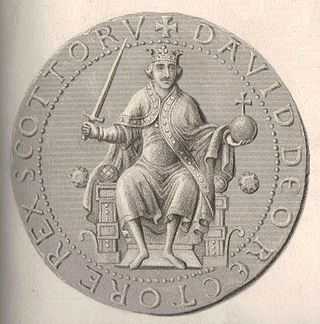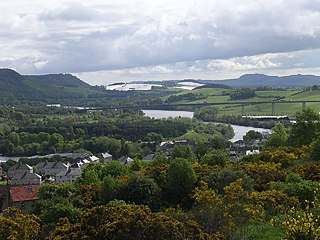Related Research Articles
Donnchad mac Máel Coluim was King of Scots. He was son of Malcolm III and his first wife Ingibiorg Finnsdottir, widow of Thorfinn Sigurdsson.
Justiciar is the English form of the medieval Latin term justiciarius or justitiarius. In England's medieval government, the Chief Justiciar was roughly equivalent to a modern Prime Minister of the United Kingdom, as the monarch's chief minister. Similar positions existed in continental Europe, particularly in Norman Italy and in the Carolingian Empire.

The history of the Scots language refers to how Anglic varieties spoken in parts of Scotland developed into modern Scots.
Brehon is a term for a historical arbitration, mediative and judicial role in Gaelic culture. Brehons were part of the system of Early Irish law, which was also simply called "Brehon law". Brehons were judges, close in importance to the chiefs.

Donnchadh was a Gall-Gaidhil prince and Scottish magnate in what is now south-western Scotland, whose career stretched from the last quarter of the 12th century until his death in 1250. His father, Gille-Brighde of Galloway, and his uncle, Uhtred of Galloway, were the two rival sons of Fergus, Prince or Lord of Galloway. As a result of Gille-Brighde's conflict with Uhtred and the Scottish monarch William the Lion, Donnchadh became a hostage of King Henry II of England. He probably remained in England for almost a decade before returning north on the death of his father. Although denied succession to all the lands of Galloway, he was granted lordship over Carrick in the north.
Causantín or Constantine of Fife is the first man known for certain to have been Mormaer of Fife.

The Kingdom of Alba was the Kingdom of Scotland between the deaths of Donald II in 900 and of Alexander III in 1286. The latter's death led indirectly to an invasion of Scotland by Edward I of England in 1296 and the First War of Scottish Independence.

Scotland in the Middle Ages concerns the history of Scotland from the departure of the Romans to the adoption of major aspects of the Renaissance in the early sixteenth century.
Scottish Society in the High Middle Ages pertains to Scottish society roughly between 900 and 1286, a period roughly corresponding to the general historical era known as the High Middle Ages.

The High Middle Ages of Scotland encompass Scotland in the era between the death of Domnall II in 900 AD and the death of King Alexander III in 1286, which was an indirect cause of the Wars of Scottish Independence.
The Justiciar of Scotia was the most senior legal office in the High Medieval Kingdom of Scotland. Scotia in this context refers to Scotland to the north of the River Forth and River Clyde. The other Justiciar positions were the Justiciar of Lothian and the Justiciar of Galloway.
The Justiciar of Lothian was an important legal office in the High Medieval Kingdom of Scotland.

The Davidian Revolution is a name given by many scholars to the changes which took place in the Kingdom of Scotland during the reign of David I (1124–1153). These included his foundation of burghs, implementation of the ideals of Gregorian Reform, foundation of monasteries, Normanisation of the Scottish government, and the introduction of feudalism through immigrant Norman and Anglo-Norman knights.

Gaelic Ireland was the Gaelic political and social order, and associated culture, that existed in Ireland from the late prehistoric era until the 17th century. It comprised the whole island before Anglo-Normans conquered parts of Ireland in the 1170s. Thereafter, it comprised that part of the country not under foreign dominion at a given time. For most of its history, Gaelic Ireland was a "patchwork" hierarchy of territories ruled by a hierarchy of kings or chiefs, who were chosen or elected through tanistry. Warfare between these territories was common. Occasionally, a powerful ruler was acknowledged as High King of Ireland. Society was made up of clans and, like the rest of Europe, was structured hierarchically according to class. Throughout this period, the economy was mainly pastoral and money was generally not used. A Gaelic Irish style of dress, music, dance, sport and art can be identified, with Irish art later merging with Anglo-Saxon styles to create Insular art.

Gowrie is a region in central Scotland and one of the original provinces of the Kingdom of Alba. It covered the eastern part of what became Perthshire. It was located to the immediate east of Atholl, and originally included the area around Perth, though that was later detached as Perthia.

The Leges inter Brettos et Scottos or Laws of the Brets and Scots was a legal codification under David I of Scotland. Only a small fragment of the original document survives, describing the penalties for several offences against people.

The Kingdom of Scotland was a sovereign state in northwest Europe traditionally said to have been founded in 843. Its territories expanded and shrank, but it came to occupy the northern third of the island of Great Britain, sharing a land border to the south with England. It suffered many invasions by the English, but under Robert the Bruce it fought a successful War of Independence and remained an independent state throughout the late Middle Ages. Following the annexation of the Hebrides and the Northern Isles from Norway in 1266 and 1472 respectively, and the final capture of the Royal Burgh of Berwick by England in 1482, the territory of the Kingdom of Scotland corresponded to that of modern-day Scotland, bounded by the North Sea to the east, the Atlantic Ocean to the north and west, and the North Channel and Irish Sea to the southwest. In 1603, James VI of Scotland became King of England, joining Scotland with England in a personal union. In 1707, during the reign of Queen Anne, the two kingdoms were united to form the Kingdom of Great Britain under the terms of the Acts of Union.
Robert Avenel was a 12th-century Anglo-Norman magnate. He was ruler of the small former Northumbrian province of Eskdale in Dumfriesshire, as well as Abercorn in West Lothian. He was one of a small number of Anglo-Norman immigrants to have been given a provincial lordship in southern Scotland in the early-to-mid 12th century. For some period in the 1170s he served as Justiciar in Lothian. He also had some part of the township of Innerwick. He seems to have held this of Walter fitz Alan. He passed this on to his younger son Vincent. His nephew Glai or Glay may have held part of Innerwick too.

Government in medieval Scotland, includes all forms of politics and administration of the minor kingdoms that emerged after the departure of the Romans from central and southern Britain in the fifth century, through the development and growth of the combined Scottish and Pictish kingdom of Alba into the kingdom of Scotland, until the adoption of the reforms of the Renaissance in the fifteenth century.

Scottish Gaelic, is a Celtic language native to Scotland. A member of the Goidelic branch of the Celtic languages, Scottish Gaelic, like Modern Irish and Manx, developed out of Middle Irish. Most of modern Scotland was once Gaelic-speaking, as evidenced especially by Gaelic-language placenames.
References
- Barrow, G.W.S., The Kingdom of the Scots, (Edinburgh, 2003)
- Kelly, Fergus, Early Irish Law, (Dublin, 1998)
- MacQueen, Hector, "Laws and Languages: Some Historical Notes from Scotland", vol 6.2 Electronic Journal of Comparative Law, (July 2002) *
- Sellar, D.H.S. "Gaelic Laws and Institutions", (2001), in M. Lynch (ed.) The Oxford Companion to Scottish History, (New York, 2001), pp. 381–2